Side Effects of Vaping and Recommendations for Quitting Smoking
VerifiedAdded on 2023/06/15
|7
|1130
|197
AI Summary
The report discusses the side effects of vaping and recommends other methods for quitting smoking such as pharmacodynamics, pharmacokinetics, pharamacotherapeutics, patient monitoring, and education.
Contribute Materials
Your contribution can guide someone’s learning journey. Share your
documents today.

Running head: VAPING
Vaping
Name of the Student:
Name of the University:
Author Note:
Vaping
Name of the Student:
Name of the University:
Author Note:
Secure Best Marks with AI Grader
Need help grading? Try our AI Grader for instant feedback on your assignments.
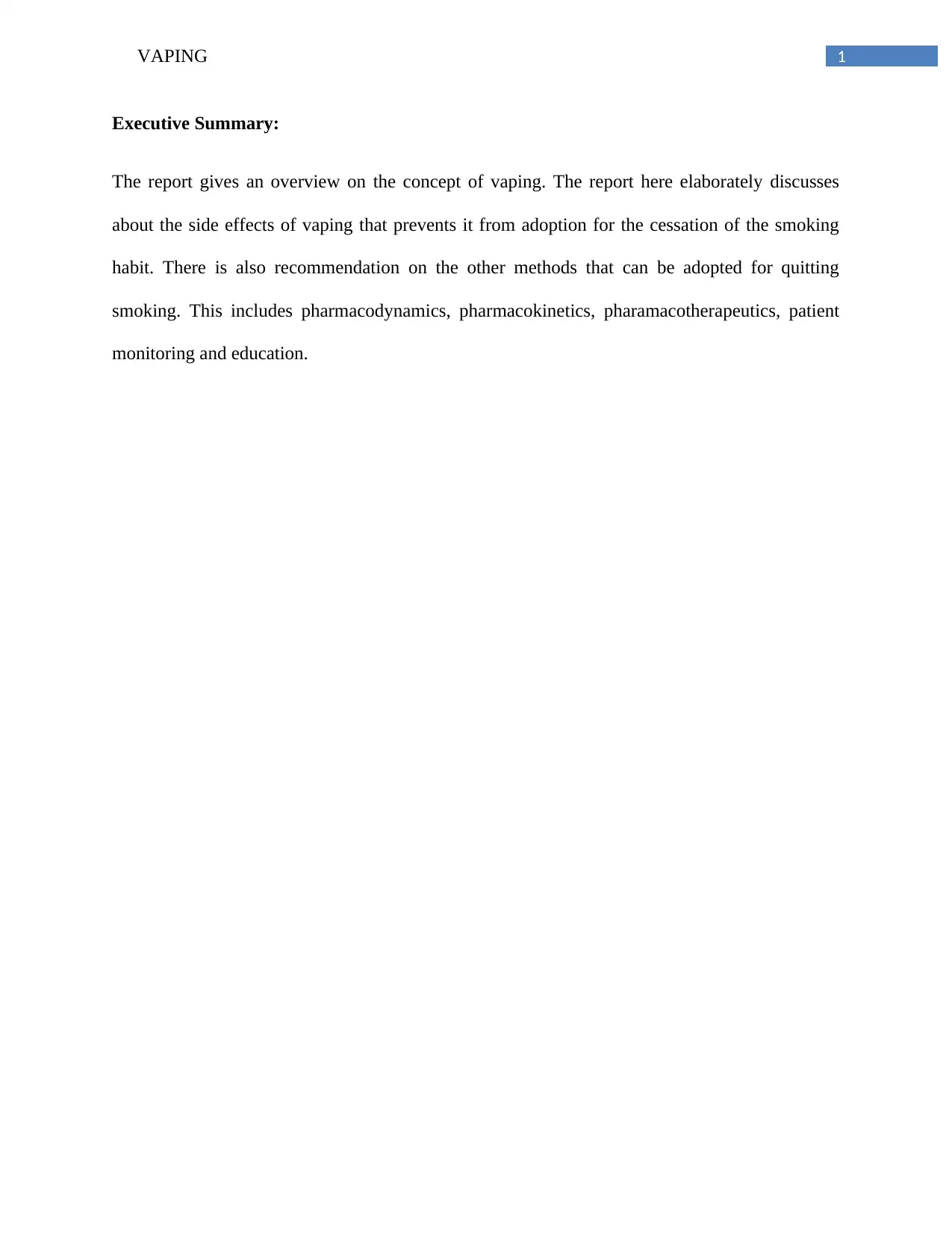
1VAPING
Executive Summary:
The report gives an overview on the concept of vaping. The report here elaborately discusses
about the side effects of vaping that prevents it from adoption for the cessation of the smoking
habit. There is also recommendation on the other methods that can be adopted for quitting
smoking. This includes pharmacodynamics, pharmacokinetics, pharamacotherapeutics, patient
monitoring and education.
Executive Summary:
The report gives an overview on the concept of vaping. The report here elaborately discusses
about the side effects of vaping that prevents it from adoption for the cessation of the smoking
habit. There is also recommendation on the other methods that can be adopted for quitting
smoking. This includes pharmacodynamics, pharmacokinetics, pharamacotherapeutics, patient
monitoring and education.
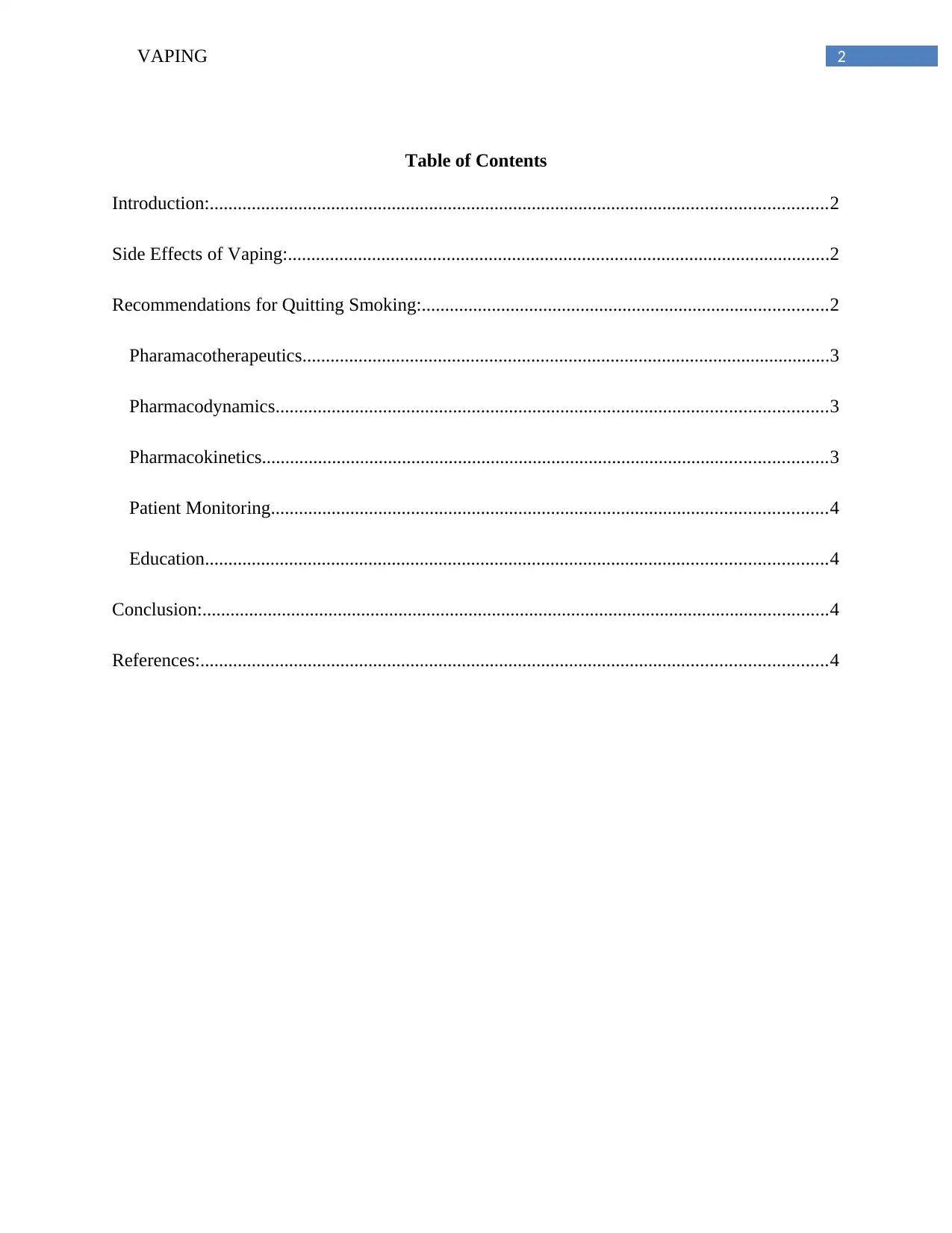
2VAPING
Table of Contents
Introduction:....................................................................................................................................2
Side Effects of Vaping:....................................................................................................................2
Recommendations for Quitting Smoking:.......................................................................................2
Pharamacotherapeutics.................................................................................................................3
Pharmacodynamics......................................................................................................................3
Pharmacokinetics.........................................................................................................................3
Patient Monitoring.......................................................................................................................4
Education.....................................................................................................................................4
Conclusion:......................................................................................................................................4
References:......................................................................................................................................4
Table of Contents
Introduction:....................................................................................................................................2
Side Effects of Vaping:....................................................................................................................2
Recommendations for Quitting Smoking:.......................................................................................2
Pharamacotherapeutics.................................................................................................................3
Pharmacodynamics......................................................................................................................3
Pharmacokinetics.........................................................................................................................3
Patient Monitoring.......................................................................................................................4
Education.....................................................................................................................................4
Conclusion:......................................................................................................................................4
References:......................................................................................................................................4
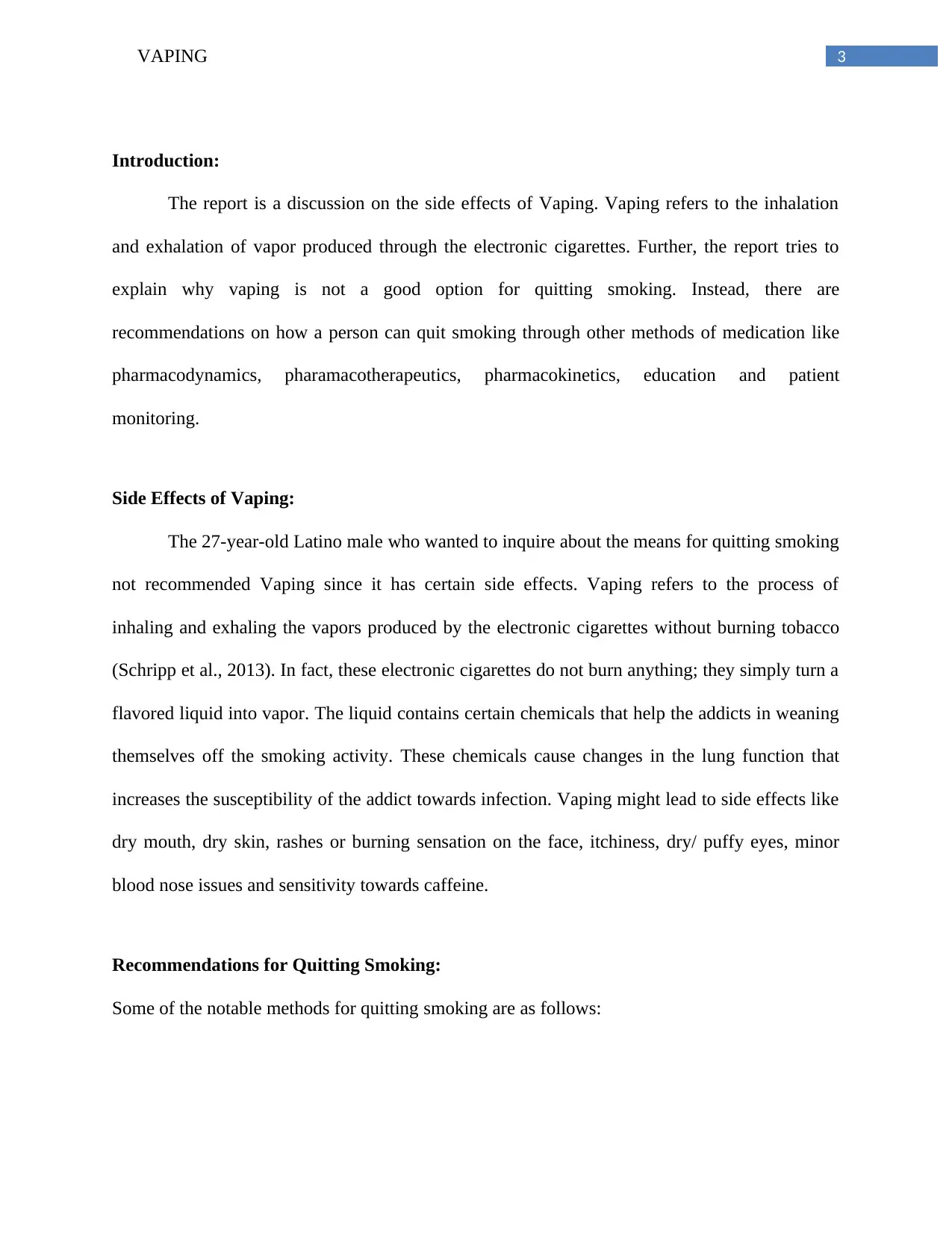
3VAPING
Introduction:
The report is a discussion on the side effects of Vaping. Vaping refers to the inhalation
and exhalation of vapor produced through the electronic cigarettes. Further, the report tries to
explain why vaping is not a good option for quitting smoking. Instead, there are
recommendations on how a person can quit smoking through other methods of medication like
pharmacodynamics, pharamacotherapeutics, pharmacokinetics, education and patient
monitoring.
Side Effects of Vaping:
The 27-year-old Latino male who wanted to inquire about the means for quitting smoking
not recommended Vaping since it has certain side effects. Vaping refers to the process of
inhaling and exhaling the vapors produced by the electronic cigarettes without burning tobacco
(Schripp et al., 2013). In fact, these electronic cigarettes do not burn anything; they simply turn a
flavored liquid into vapor. The liquid contains certain chemicals that help the addicts in weaning
themselves off the smoking activity. These chemicals cause changes in the lung function that
increases the susceptibility of the addict towards infection. Vaping might lead to side effects like
dry mouth, dry skin, rashes or burning sensation on the face, itchiness, dry/ puffy eyes, minor
blood nose issues and sensitivity towards caffeine.
Recommendations for Quitting Smoking:
Some of the notable methods for quitting smoking are as follows:
Introduction:
The report is a discussion on the side effects of Vaping. Vaping refers to the inhalation
and exhalation of vapor produced through the electronic cigarettes. Further, the report tries to
explain why vaping is not a good option for quitting smoking. Instead, there are
recommendations on how a person can quit smoking through other methods of medication like
pharmacodynamics, pharamacotherapeutics, pharmacokinetics, education and patient
monitoring.
Side Effects of Vaping:
The 27-year-old Latino male who wanted to inquire about the means for quitting smoking
not recommended Vaping since it has certain side effects. Vaping refers to the process of
inhaling and exhaling the vapors produced by the electronic cigarettes without burning tobacco
(Schripp et al., 2013). In fact, these electronic cigarettes do not burn anything; they simply turn a
flavored liquid into vapor. The liquid contains certain chemicals that help the addicts in weaning
themselves off the smoking activity. These chemicals cause changes in the lung function that
increases the susceptibility of the addict towards infection. Vaping might lead to side effects like
dry mouth, dry skin, rashes or burning sensation on the face, itchiness, dry/ puffy eyes, minor
blood nose issues and sensitivity towards caffeine.
Recommendations for Quitting Smoking:
Some of the notable methods for quitting smoking are as follows:
Secure Best Marks with AI Grader
Need help grading? Try our AI Grader for instant feedback on your assignments.
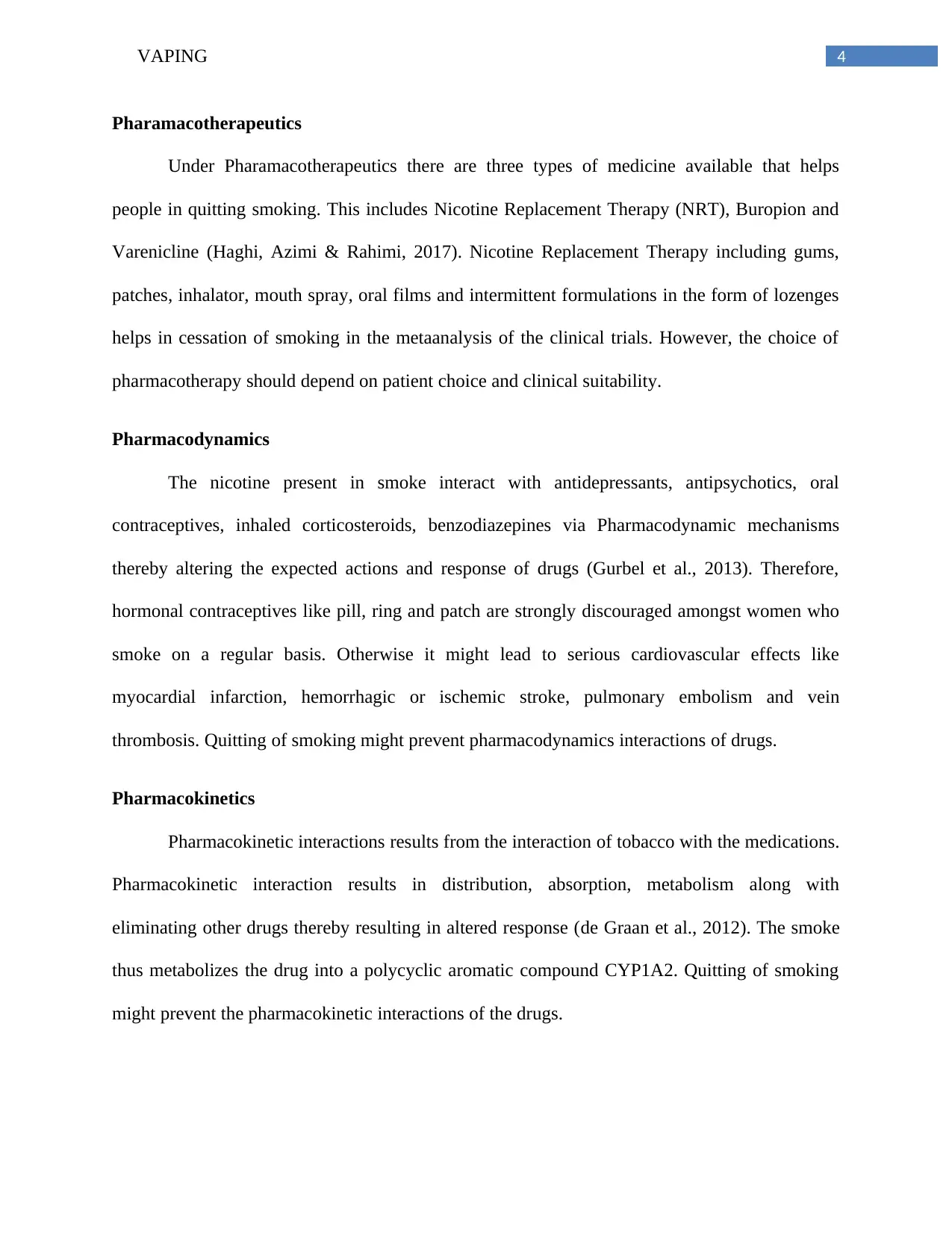
4VAPING
Pharamacotherapeutics
Under Pharamacotherapeutics there are three types of medicine available that helps
people in quitting smoking. This includes Nicotine Replacement Therapy (NRT), Buropion and
Varenicline (Haghi, Azimi & Rahimi, 2017). Nicotine Replacement Therapy including gums,
patches, inhalator, mouth spray, oral films and intermittent formulations in the form of lozenges
helps in cessation of smoking in the metaanalysis of the clinical trials. However, the choice of
pharmacotherapy should depend on patient choice and clinical suitability.
Pharmacodynamics
The nicotine present in smoke interact with antidepressants, antipsychotics, oral
contraceptives, inhaled corticosteroids, benzodiazepines via Pharmacodynamic mechanisms
thereby altering the expected actions and response of drugs (Gurbel et al., 2013). Therefore,
hormonal contraceptives like pill, ring and patch are strongly discouraged amongst women who
smoke on a regular basis. Otherwise it might lead to serious cardiovascular effects like
myocardial infarction, hemorrhagic or ischemic stroke, pulmonary embolism and vein
thrombosis. Quitting of smoking might prevent pharmacodynamics interactions of drugs.
Pharmacokinetics
Pharmacokinetic interactions results from the interaction of tobacco with the medications.
Pharmacokinetic interaction results in distribution, absorption, metabolism along with
eliminating other drugs thereby resulting in altered response (de Graan et al., 2012). The smoke
thus metabolizes the drug into a polycyclic aromatic compound CYP1A2. Quitting of smoking
might prevent the pharmacokinetic interactions of the drugs.
Pharamacotherapeutics
Under Pharamacotherapeutics there are three types of medicine available that helps
people in quitting smoking. This includes Nicotine Replacement Therapy (NRT), Buropion and
Varenicline (Haghi, Azimi & Rahimi, 2017). Nicotine Replacement Therapy including gums,
patches, inhalator, mouth spray, oral films and intermittent formulations in the form of lozenges
helps in cessation of smoking in the metaanalysis of the clinical trials. However, the choice of
pharmacotherapy should depend on patient choice and clinical suitability.
Pharmacodynamics
The nicotine present in smoke interact with antidepressants, antipsychotics, oral
contraceptives, inhaled corticosteroids, benzodiazepines via Pharmacodynamic mechanisms
thereby altering the expected actions and response of drugs (Gurbel et al., 2013). Therefore,
hormonal contraceptives like pill, ring and patch are strongly discouraged amongst women who
smoke on a regular basis. Otherwise it might lead to serious cardiovascular effects like
myocardial infarction, hemorrhagic or ischemic stroke, pulmonary embolism and vein
thrombosis. Quitting of smoking might prevent pharmacodynamics interactions of drugs.
Pharmacokinetics
Pharmacokinetic interactions results from the interaction of tobacco with the medications.
Pharmacokinetic interaction results in distribution, absorption, metabolism along with
eliminating other drugs thereby resulting in altered response (de Graan et al., 2012). The smoke
thus metabolizes the drug into a polycyclic aromatic compound CYP1A2. Quitting of smoking
might prevent the pharmacokinetic interactions of the drugs.
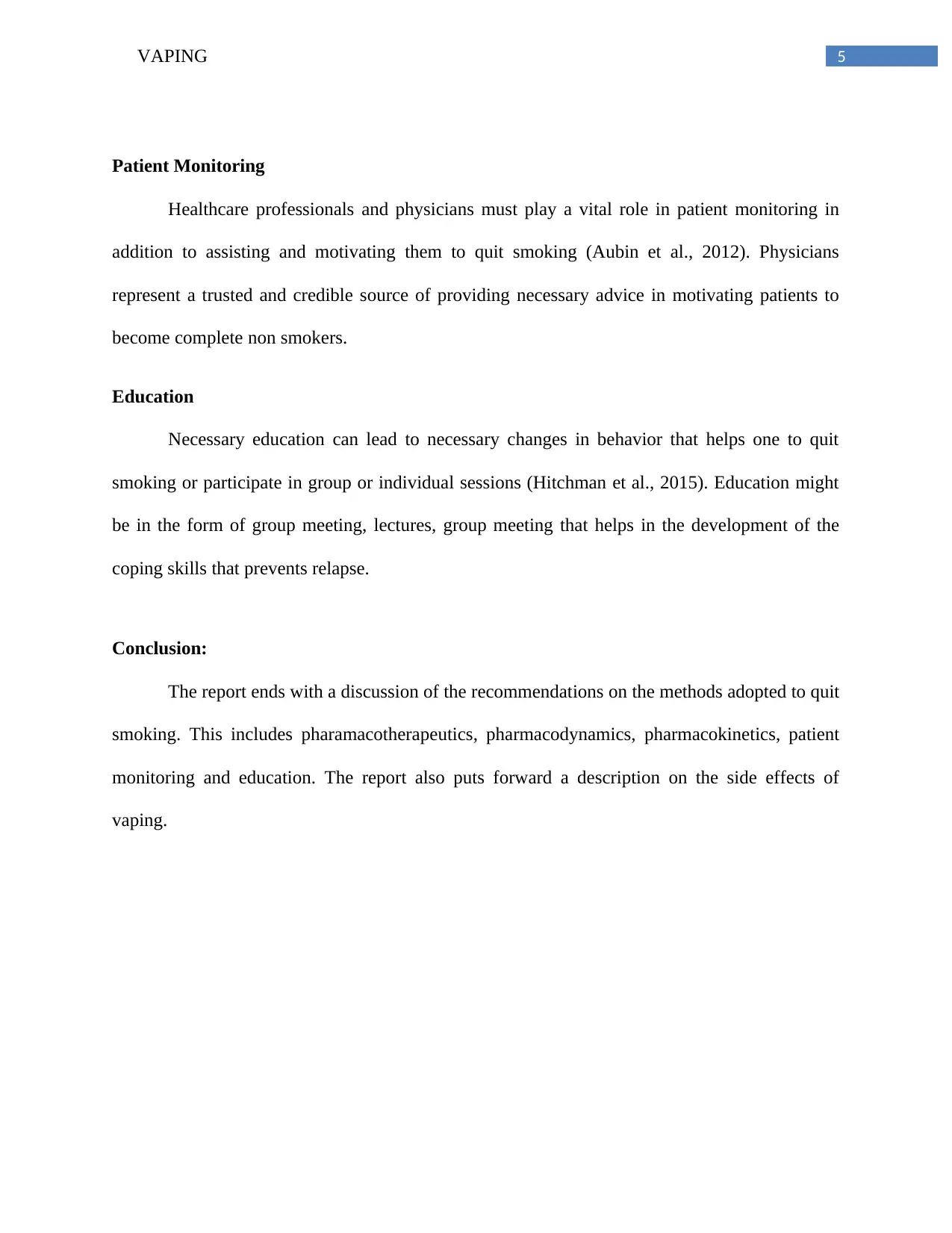
5VAPING
Patient Monitoring
Healthcare professionals and physicians must play a vital role in patient monitoring in
addition to assisting and motivating them to quit smoking (Aubin et al., 2012). Physicians
represent a trusted and credible source of providing necessary advice in motivating patients to
become complete non smokers.
Education
Necessary education can lead to necessary changes in behavior that helps one to quit
smoking or participate in group or individual sessions (Hitchman et al., 2015). Education might
be in the form of group meeting, lectures, group meeting that helps in the development of the
coping skills that prevents relapse.
Conclusion:
The report ends with a discussion of the recommendations on the methods adopted to quit
smoking. This includes pharamacotherapeutics, pharmacodynamics, pharmacokinetics, patient
monitoring and education. The report also puts forward a description on the side effects of
vaping.
Patient Monitoring
Healthcare professionals and physicians must play a vital role in patient monitoring in
addition to assisting and motivating them to quit smoking (Aubin et al., 2012). Physicians
represent a trusted and credible source of providing necessary advice in motivating patients to
become complete non smokers.
Education
Necessary education can lead to necessary changes in behavior that helps one to quit
smoking or participate in group or individual sessions (Hitchman et al., 2015). Education might
be in the form of group meeting, lectures, group meeting that helps in the development of the
coping skills that prevents relapse.
Conclusion:
The report ends with a discussion of the recommendations on the methods adopted to quit
smoking. This includes pharamacotherapeutics, pharmacodynamics, pharmacokinetics, patient
monitoring and education. The report also puts forward a description on the side effects of
vaping.
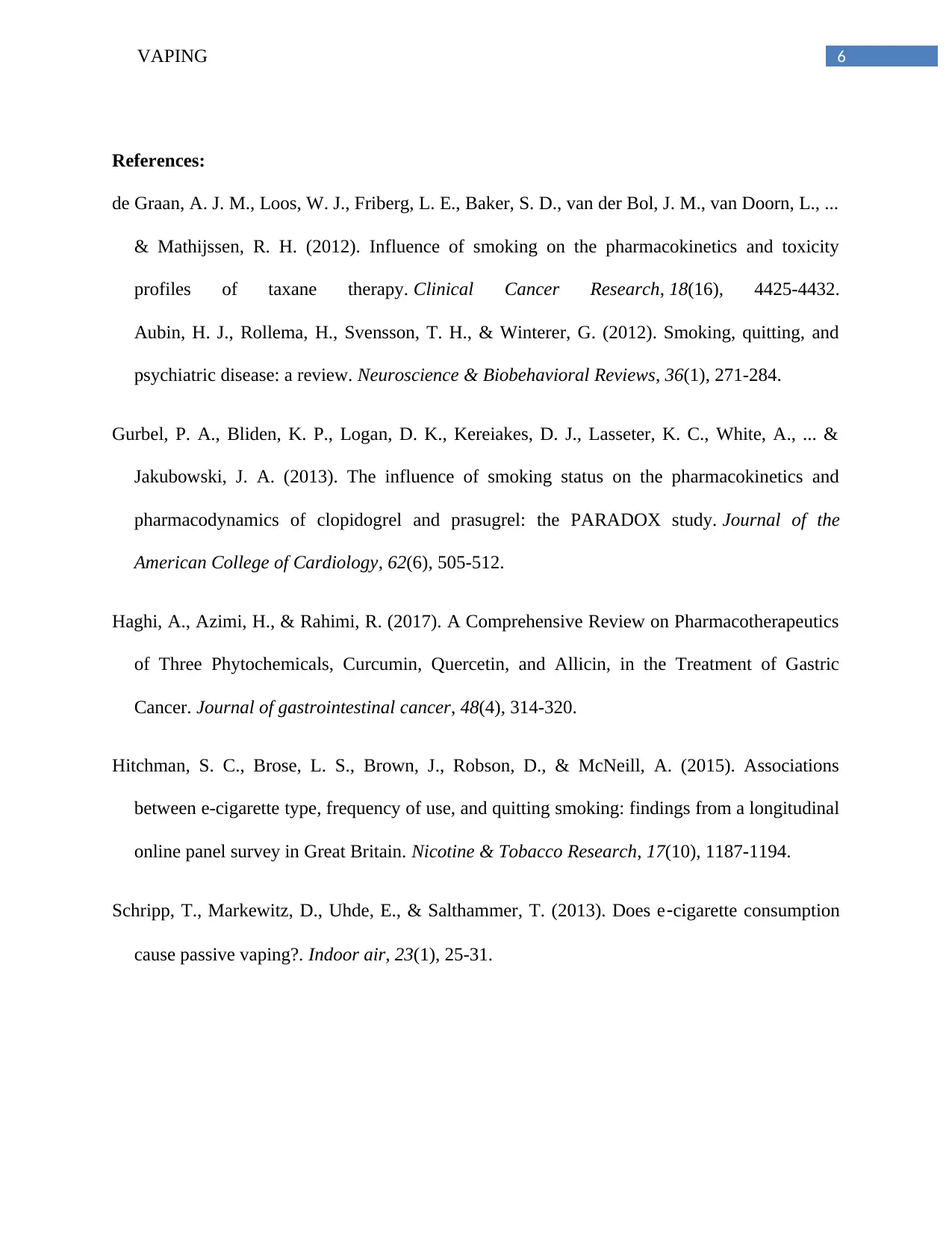
6VAPING
References:
de Graan, A. J. M., Loos, W. J., Friberg, L. E., Baker, S. D., van der Bol, J. M., van Doorn, L., ...
& Mathijssen, R. H. (2012). Influence of smoking on the pharmacokinetics and toxicity
profiles of taxane therapy. Clinical Cancer Research, 18(16), 4425-4432.
Aubin, H. J., Rollema, H., Svensson, T. H., & Winterer, G. (2012). Smoking, quitting, and
psychiatric disease: a review. Neuroscience & Biobehavioral Reviews, 36(1), 271-284.
Gurbel, P. A., Bliden, K. P., Logan, D. K., Kereiakes, D. J., Lasseter, K. C., White, A., ... &
Jakubowski, J. A. (2013). The influence of smoking status on the pharmacokinetics and
pharmacodynamics of clopidogrel and prasugrel: the PARADOX study. Journal of the
American College of Cardiology, 62(6), 505-512.
Haghi, A., Azimi, H., & Rahimi, R. (2017). A Comprehensive Review on Pharmacotherapeutics
of Three Phytochemicals, Curcumin, Quercetin, and Allicin, in the Treatment of Gastric
Cancer. Journal of gastrointestinal cancer, 48(4), 314-320.
Hitchman, S. C., Brose, L. S., Brown, J., Robson, D., & McNeill, A. (2015). Associations
between e-cigarette type, frequency of use, and quitting smoking: findings from a longitudinal
online panel survey in Great Britain. Nicotine & Tobacco Research, 17(10), 1187-1194.
Schripp, T., Markewitz, D., Uhde, E., & Salthammer, T. (2013). Does e‐cigarette consumption
cause passive vaping?. Indoor air, 23(1), 25-31.
References:
de Graan, A. J. M., Loos, W. J., Friberg, L. E., Baker, S. D., van der Bol, J. M., van Doorn, L., ...
& Mathijssen, R. H. (2012). Influence of smoking on the pharmacokinetics and toxicity
profiles of taxane therapy. Clinical Cancer Research, 18(16), 4425-4432.
Aubin, H. J., Rollema, H., Svensson, T. H., & Winterer, G. (2012). Smoking, quitting, and
psychiatric disease: a review. Neuroscience & Biobehavioral Reviews, 36(1), 271-284.
Gurbel, P. A., Bliden, K. P., Logan, D. K., Kereiakes, D. J., Lasseter, K. C., White, A., ... &
Jakubowski, J. A. (2013). The influence of smoking status on the pharmacokinetics and
pharmacodynamics of clopidogrel and prasugrel: the PARADOX study. Journal of the
American College of Cardiology, 62(6), 505-512.
Haghi, A., Azimi, H., & Rahimi, R. (2017). A Comprehensive Review on Pharmacotherapeutics
of Three Phytochemicals, Curcumin, Quercetin, and Allicin, in the Treatment of Gastric
Cancer. Journal of gastrointestinal cancer, 48(4), 314-320.
Hitchman, S. C., Brose, L. S., Brown, J., Robson, D., & McNeill, A. (2015). Associations
between e-cigarette type, frequency of use, and quitting smoking: findings from a longitudinal
online panel survey in Great Britain. Nicotine & Tobacco Research, 17(10), 1187-1194.
Schripp, T., Markewitz, D., Uhde, E., & Salthammer, T. (2013). Does e‐cigarette consumption
cause passive vaping?. Indoor air, 23(1), 25-31.
1 out of 7
Your All-in-One AI-Powered Toolkit for Academic Success.
+13062052269
info@desklib.com
Available 24*7 on WhatsApp / Email
![[object Object]](/_next/static/media/star-bottom.7253800d.svg)
Unlock your academic potential
© 2024 | Zucol Services PVT LTD | All rights reserved.
